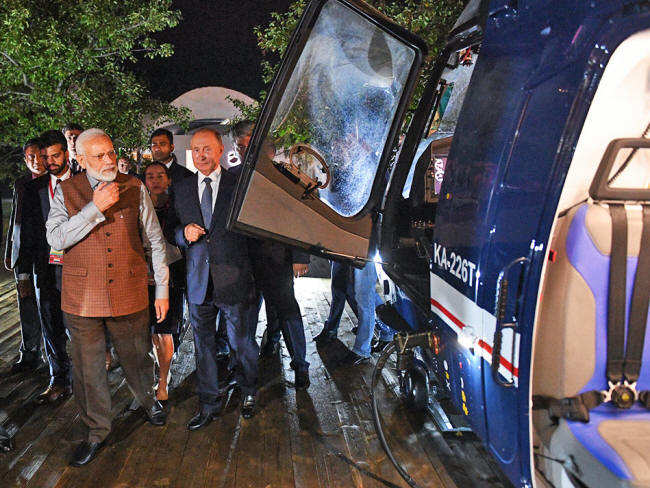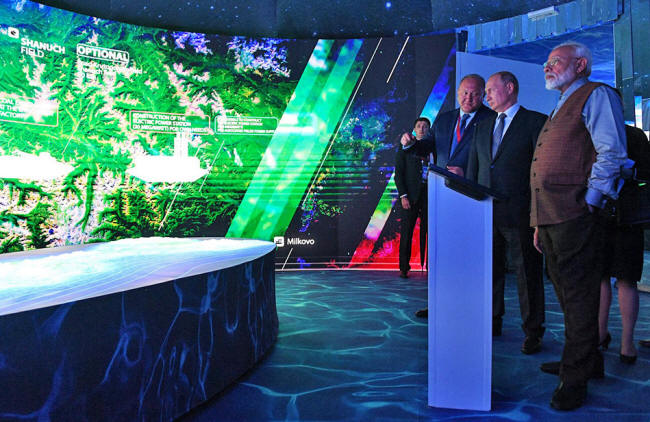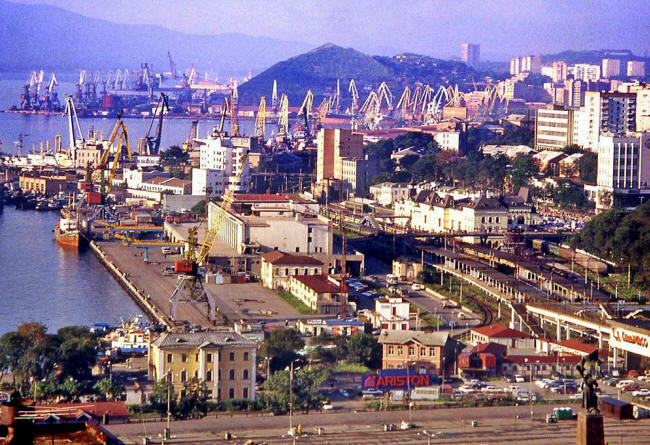|
and Russian President Vladimir Putin review a Kamov KA-226T helicopter painted in Indian Army colors at the Eastern Economic Forum in Vladivostok, Russia on Wednesday.
Photo:
Grigory Sysoev / Sputnik / AFP discuss business and joint ventures at an economic conference in the Far East...
There's no way to follow the complex inner workings of the Eurasia integration process without considering what takes place annually at the Eastern Economic Forum in Vladivostok.
BRICS for the moment may be dead - considering the nasty cocktail of economic brutalism and social intolerance delivered by the incendiary,
Yet RIC - Russia-India-China - is alive, well and thriving.
A vast menu was on the table, from aviation to energy.
It included the,
Indian Prime Minister Narendra Modi, right, and Russian leader Vladimir Putin, center right, tour an exhibition at the 5th Eastern Economic Forum in Vladivostok on Sept 4. Photo: Grigory Sysoev / Sputnik / AFP
All that seems to spell out a delightful revival of the notorious Soviet-era motto Rusi-Hindi bhai bhai (Russians and Indians are brothers).
And all that would be complemented by what may be described as a new push for a Russia-India Maritime Silk Road - revival of the Chennai-Vladivostok maritime corridor.
Arctic to the Indian Ocean
Chennai-Vladivostok may easily interlock with the Chinese-driven Maritime Silk Road from the South China Sea to the Indian Ocean and beyond, part of the Belt and Road Initiative.
Simultaneously, it may add another layer to Russia's "pivot to Asia".
The "pivot to Asia" was inevitably discussed in detail in Vladivostok.
As energy or trade corridors, the fact is both Chennai-Vladivostok and Belt and Road spell out Eurasia integration.
India in this particular case will profit from Russian resources traveling all the way from the Arctic and the Russian Far East, while Russia will profit from more Indian energy companies investing in the Russian Far East.
The fine-print details of the Russia-China "comprehensive strategic partnership" as well as Russia's push for Greater Eurasia were also discussed at length in Vladivostok.
A crucial factor is that as well as China, Russia and India have made sure their trade and economic relationship with Iran - a key node of the ongoing, complex Eurasian integration project - remains.
As Russia and India stressed:
Most of all, Russia and India reaffirmed an essential commitment since BRICS was set up over a decade ago.
They will continue to,
One can easily imagine how this will go down among Washington sectors bent on luring India into the Trump administration's Indo-Pacific strategy, which is a de facto China containment mechanism.
Luring Chinese capital
In terms of Eurasian integration, what's happening in the Russian Far East totally interlocks with a special report on China's grand strategy across the Eurasian heartland presented in Moscow earlier this week.
Vladivostock harbor. Photo: Wikimedia Commons
As for Russia's own "pivot to Asia," an essential plank of which is integration of the Russian Far East, inevitably it's bound to remain a complex issue.
A sobering report by the Valdai club meticulously details the pitfalls.
Here are the highlights:
The bottom line is that for all the pledges in the "comprehensive strategic partnership," the Russian Far East has not yet built an effective model for cooperation with China.
That will certainly change in the medium term as Beijing is bound to turbo-charge its,
What this means is that Vladivostok may well end up as a major hub for Russia and India after all.
|




